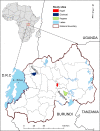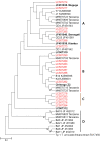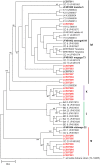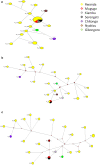Sequence diversity of cytotoxic T cell antigens and satellite marker analysis of Theileria parva informs the immunization against East Coast fever in Rwanda
- PMID: 32894166
- PMCID: PMC7487574
- DOI: 10.1186/s13071-020-04322-9
Sequence diversity of cytotoxic T cell antigens and satellite marker analysis of Theileria parva informs the immunization against East Coast fever in Rwanda
Abstract
Background: East Coast fever (ECF) caused by Theileria parva is endemic in Rwanda. In this study, the antigenic and genetic diversity of T. parva coupled with immunization and field challenge were undertaken to provide evidence for the introduction of ECF immunization in Rwanda.
Methods: Blood collected from cattle in the field was screened for T. parva using ELISA and PCR targeting the p104 gene. Tp1 and Tp2 gene sequences were generated from field samples and from Gikongoro and Nyakizu isolates. Furthermore, multilocus genotype data was generated using 5 satellite markers and an immunization challenge trial under field conditions using Muguga cocktail vaccine undertaken.
Results: Out of 120 samples, 44 and 20 were positive on ELISA and PCR, respectively. Antigenic diversity of the Tp1 and Tp2 gene sequences revealed an abundance of Muguga, Kiambu and Serengeti epitopes in the samples. A further three clusters were observed on both Tp1 and Tp2 phylogenetic trees; two clusters comprising of field samples and vaccine isolates and the third cluster comprising exclusively of Rwanda samples. Both antigens exhibited purifying selection with no positive selection sites. In addition, satellite marker analysis revealed that field samples possessed both shared alleles with Muguga cocktail on all loci and also a higher proportion of unique alleles. The Muguga cocktail (Muguga, Kiambu and Serengeti) genotype compared to other vaccine isolates, was the most represented in the field samples. Further low genetic sub-structuring (FST = 0.037) coupled with linkage disequilibrium between Muguga cocktail and the field samples was observed. Using the above data to guide a field immunization challenge trial comprising 41 immunized and 40 control animals resulted in 85% seroconversion in the immunized animals and an efficacy of vaccination of 81.7%, implying high protection against ECF.
Conclusions: Antigenic and genetic diversity analysis of T. parva facilitated the use of Muguga cocktail vaccine in field conditions. A protection level of 81.7% was achieved, demonstrating the importance of combining molecular tools with field trials to establish the suitability of implementation of immunization campaigns. Based on the information in this study, Muguga cocktail immunization in Rwanda has a potential to produce desirable results.
Keywords: ECF; Immunization; Muguga cocktail; Sub-structuring; Theileria parva; Tp1; Tp2.
Conflict of interest statement
The authors declare that they have no competing interests.
Figures







Similar articles
-
Molecular characterization and population genetics of Theileria parva in Burundi's unvaccinated cattle: Towards the introduction of East Coast fever vaccine.PLoS One. 2021 May 17;16(5):e0251500. doi: 10.1371/journal.pone.0251500. eCollection 2021. PLoS One. 2021. PMID: 33999934 Free PMC article.
-
Genes encoding two Theileria parva antigens recognized by CD8+ T-cells exhibit sequence diversity in South Sudanese cattle populations but the majority of alleles are similar to the Muguga component of the live vaccine cocktail.PLoS One. 2017 Feb 23;12(2):e0171426. doi: 10.1371/journal.pone.0171426. eCollection 2017. PLoS One. 2017. PMID: 28231338 Free PMC article.
-
Diversity of two Theileria parva CD8+ antigens in cattle and buffalo-derived parasites in Tanzania.Ticks Tick Borne Dis. 2019 Aug;10(5):1003-1017. doi: 10.1016/j.ttbdis.2019.05.007. Epub 2019 May 22. Ticks Tick Borne Dis. 2019. PMID: 31151920
-
A review of recent research on Theileria parva: Implications for the infection and treatment vaccination method for control of East Coast fever.Transbound Emerg Dis. 2020 Mar;67 Suppl 1:56-67. doi: 10.1111/tbed.13325. Transbound Emerg Dis. 2020. PMID: 32174044 Review.
-
Immunization against diseases caused by Theileria parva: a review.Trop Med Int Health. 1999 Sep;4(9):A12-20. doi: 10.1046/j.1365-3156.1999.00446.x. Trop Med Int Health. 1999. PMID: 10540307 Review.
Cited by
-
Safety and Efficacy of the East Coast Fever Muguga Cocktail Vaccine: A Systematic Review.Vaccines (Basel). 2021 Nov 12;9(11):1318. doi: 10.3390/vaccines9111318. Vaccines (Basel). 2021. PMID: 34835249 Free PMC article. Review.
-
Antigenic Diversity in Theileria parva Populations From Sympatric Cattle and African Buffalo Analyzed Using Long Read Sequencing.Front Genet. 2021 Jul 15;12:684127. doi: 10.3389/fgene.2021.684127. eCollection 2021. Front Genet. 2021. PMID: 34335691 Free PMC article.
-
Molecular characterization and population genetics of Theileria parva in Burundi's unvaccinated cattle: Towards the introduction of East Coast fever vaccine.PLoS One. 2021 May 17;16(5):e0251500. doi: 10.1371/journal.pone.0251500. eCollection 2021. PLoS One. 2021. PMID: 33999934 Free PMC article.
-
Sequence Diversity of Tp1 and Tp2 Antigens and Population Genetic Analysis of Theileria parva in Unvaccinated Cattle in Zambia's Chongwe and Chisamba Districts.Pathogens. 2022 Jan 19;11(2):114. doi: 10.3390/pathogens11020114. Pathogens. 2022. PMID: 35215058 Free PMC article.
-
Geospatial and modelling analyses reveal diverse tick and tick-associated microbes in the East African Community.Infect Dis Poverty. 2025 May 22;14(1):39. doi: 10.1186/s40249-025-01310-y. Infect Dis Poverty. 2025. PMID: 40405314 Free PMC article. Review.
References
-
- Norval RAI, Perry BD, Young AS. The epidemiology of theileriosis in Africa. London: Academic Press; 1992.
-
- Minjauw B, McLeod BA. Tick-borne diseases and poverty. The impact of ticks and tick-borne diseases on thelivelihoods of small-scale and marginal livestock owners in India and eastern and southern Africa. UK: Research Report, DFID Animal Health Programme, Centre for Tropical Veterinary Medicine, University of Edinburgh; 2003. pp 124
-
- GALVmed. GALVmed & East Coast Fever. The CTTBD ECF vaccine: greater opportunity to control East Coast fever and other tick-borne diseases in Africa. Pentlands Science Park, Bush Loan, Edinburgh; 2010.
-
- Gettinby G. The epidemiology of theileriosis in Africa. Parasitol Today. 1993;9:272. doi: 10.1016/0169-4758(93)90075-Q. - DOI
-
- National Institute of Statistics of Rwanda (NISR). 2017. http://www.statistics.gov.rw/publication/statistical-yearbook-2017. Accessed 27 Aug 2019
MeSH terms
Substances
Grants and funding
LinkOut - more resources
Full Text Sources
Medical
Miscellaneous

